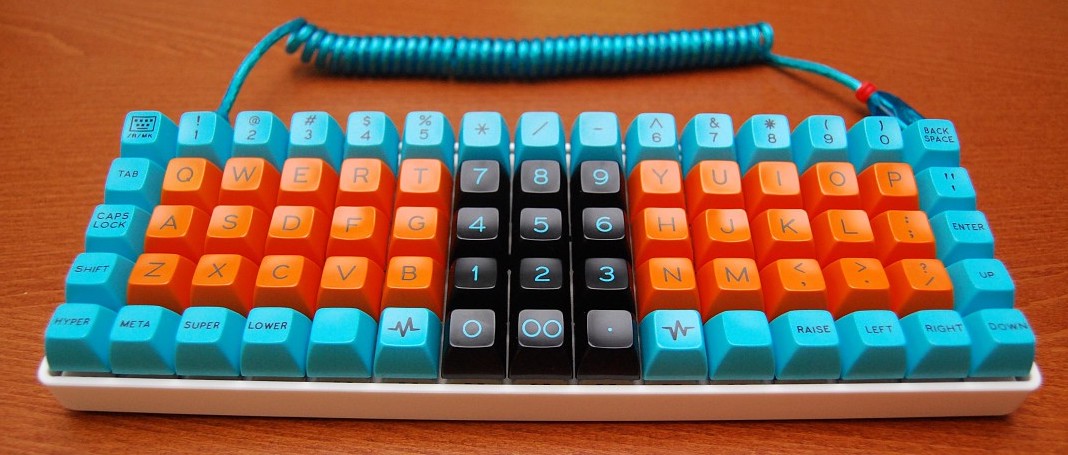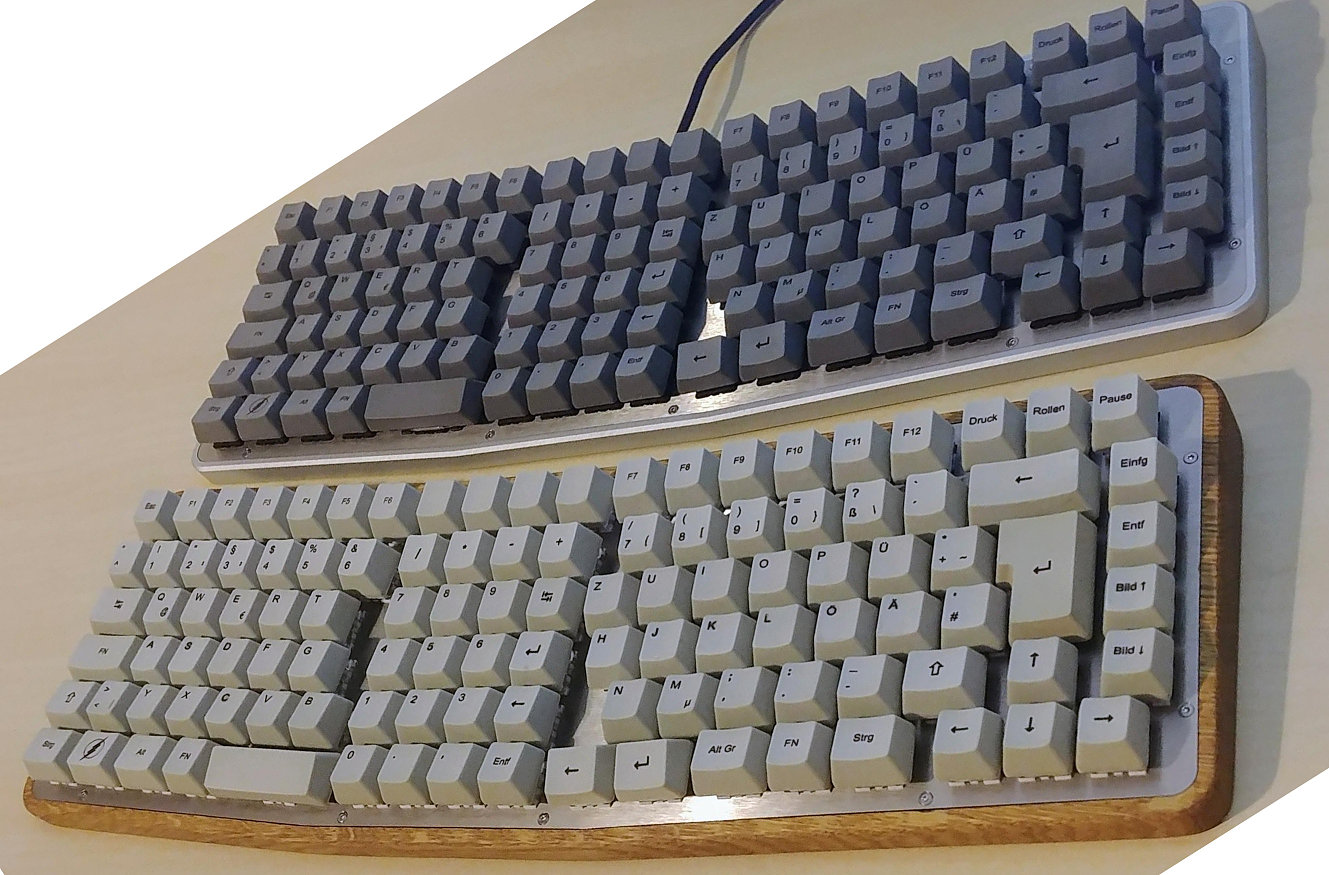X No Chord Keyboard
Features
- Dvorak Keyboard Layout for letter efficiency.
- Punctuation and symbols key locations are based on character frequency and finger comfort.
- One single key press for frequently used operations. For example, {Copy, Paste, Undo}, and {close tab, previous window}.
- The 2 scroll wheels are physically same as well-designed mouse wheels. One of the scroll wheel should send same signal as {PageUp, PageDown}. The other should send should send {F16, F17} signals, to be programed for one of next/prev {tab, app, window}.

〔see Keyboards with Wheel n Knobs〕 - Wheel is also used for sound level control. No need to press Volume Up key 10 times or take several seconds to hold it down.
- Rotary switch for sound level eliminates the need for a Mute button.
- Keys for numbers arranged in a square in the middle. No need to hold Shift key. No need to turn on NumLock. Faster touch-type numerical data entry than the traditional top row.
- Major improvement over conventional keyboard for programers. Most frequently used symbols do not need Shift key. Symbols arranged according to use frequency in computer language source code. 〔see Computer Languages Characters Frequency〕
- Split key groups for each hand, so you don't have to bend wrist.
- Each hand can reach all keys easily without stretching. (In traditional computer keyboard, the right pinky has to strech to reach several keys: Backspace ⌫ ' - [ ] \. 〔see Keyboard Design Flaws〕)
- The vertical columns are straight. Allows straight up/down finger movement. They are not slanted like in traditional computer keyboard.
- Designed for English and other major world languages. (For at least: Chinese pinyin, Spanish, Portuguese, German, French.) This layout should be more efficient than any local language layout. 〔see International Keyboard Layouts〕
- {Caps Lock, NumLock} are eliminated. These are annoying, rarely used, and introduces state complexity.
- No obsolete keys such as {Pause/Break, SysRq, ScrollLock, Insert}.
- No keys for {Sleep, Power}, that are press at most few times a day.
Notes:
- The key ❖ is Windows logo key or Apple's ⌘ command key. 〔see Unicode: Keyboard Symbols ⌘ ↵ ⌫〕
- The 2 wheels position and orientation need to be thought about.
- The wheels are optional, due to not being a common component for at least DIY keyboard.
- The close key ⌧ is designed to close current tab (Ctrl+w).
- The little gabs in various places are critical. They make it possible to feel the key location without visual contact. The keyboard must not become a uniform grid such as the TypeMatrix Keyboard nor eye-candy like the Apple Keyboards.
- The special keys, F1, F2, Copy etc, must be actual keys. They must not be some rubber buttons.
- The labels for the letters should be lower case, not caps. This is also done by Chromebook Keyboard.
There should not be a QWERTY version. This makes it simple.(QWERTY version should probably be available, else there is no business.)- This physical layout is designed to be improvement over existing Ergonomic Keyboards, yet not too radical.
- This is not intended to be radical keyboard. It is intended to be cheap and mostly compatible with computer keyboard, but offers major improvements by some simple changes of the worst aspects. The keyboard overall shape should be flat, not curved or bowl-shaped as Kinesis Keyboard. The layout improves 80% of traditional keyboard, but acceptable for average people to adopt.
- Should work out of the box for mom and pop. However, for tech geeks, all keys are exposed to OS and can be remapped anyway they want. There's no hardware-wired keys such as Fn.
- The keyboard firmware should probably be the open source QMK. 〔see QMK Configurator Tutorial〕
- This keyboard must not rely on software to work for basic functions. It should be plug and play without installing any software or the need to switch to a different keyboard layout in OS. All keys have standard USB scancode or such.
- Aimed at mass production to the mass market, using cheap components. Perhaps no more than $70. This makes it possible for mass adoption. For example, similar to Microsoft Comfort Curve Keyboard that was about $20.
- Possibly a high-end model, using Mechanical Key Switchs, perhaps $250.
xd75re keyboard
Someone has built a similar keyboard.

They need to have gaps around the numpad.

dizygotic keyboard
This one, it should be straight, not bent. Because the idea with number pad in the middle, is that it should solve most of the wrist bending problem without being split or tented. Straight form makes it simpler and easy to carry. If you gonna have a bend angle a little, might as well angle all the way and not have numpad in middle idea.

TODO
possibly add keys for {Browser, calculator, app1, app2}, and a {zoom in, zoom out} teeter knob as in Microsoft Keyboard 4000 .
Do research to find out all non-ASCII chars used in other langs. Their frequency. Consult the NEO layout 〔see German Ergonomic Keyboard Layouts: de-ergo, ADNW〕, Bépo Layout 〔see French Keyboard Ergonomic Layout〕, Portuguese: pt-Nativo etc. The goal is to create a letter layout such that it is more efficient to type frequently needed non-English letters but more efficient than any local layout, for the top 5 most popular languages.
see:
- Character Frequency Counter
- Computer Languages Characters Frequency
- Pinyin Letter Frequency 拼音字母頻率
- French Letter Frequency for Keyboard Layout
- German Keyboard Layout
- Russian Keyboard Layout
back to Laptop Keyboards